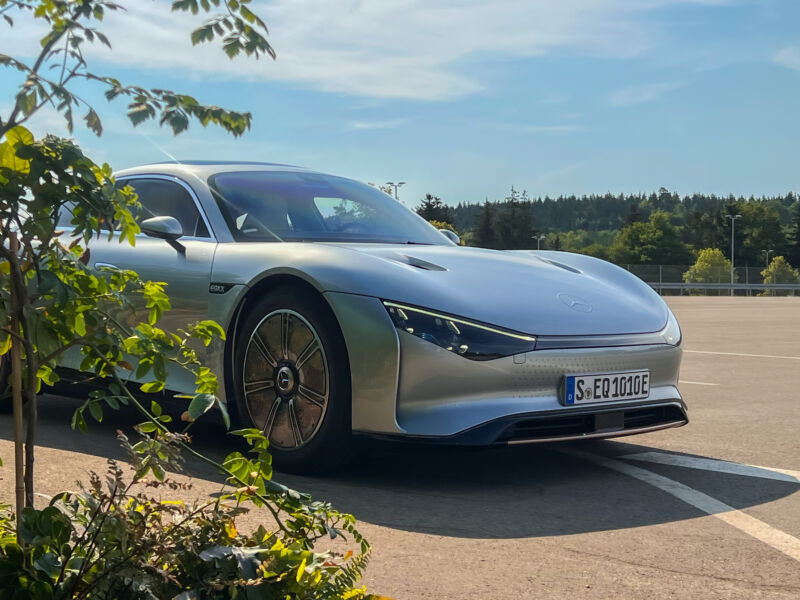
IMMENDINGEN, GERMANY—Driving off in the Mercedes-Benz Vision EQXX was slightly more stressful than I anticipated. Not that it's difficult to drive, or to see out of the low-slung streamliner, but it's also the only one in existence. Mercedes wouldn't tell us the program's exact budget, simply warning us that the sole EQXX should be considered priceless, but I'd guess somewhere in the range of three Bugatti Pur Sports.
Like the Bugatti, the EQXX was built to an engineering brief—in this case to build an electric vehicle capable of at least 621 miles (1,000km) on a single charge. Also like the Bugatti, it's road-legal: in April of this year, less than two years after the project was given the green light, the team drove the EV 625 miles (1,006 km) from Sindelfingen in Germany to Cassis, France, arriving with a 15 percent state of charge in the battery.
Two months later, they followed that up with a longer drive that involved descending down fewer mountains, driving from Stuttgart, Germany to the Silverstone racetrack in the UK, where reigning Formula E champion Nyck de Vries then used the remaining charge to drive some hot laps, the car eventually completing 747 miles (1,202 km) before coming to a halt in the pit lane.
But this is not Bugatti and there are no plans for a low volume production run, not even at eye-waveringly expensive prices. The Vision EQXX is a one-off, a concept car come to life, but more fully realized than any other concept I've yet encountered. A pure engineering exercise or world record breaker wouldn't bother with a functional infotainment system that uses a single 44-inch 8k display, nor a completely trimmed interior, even if it is one that uses a cactus fiber fabric instead of leather, bamboo fiber carpets, and a biotech-derived silk, among other innovations.
And despite the priceless nature of this low-drag EV, Mercedes let Ars drive it.
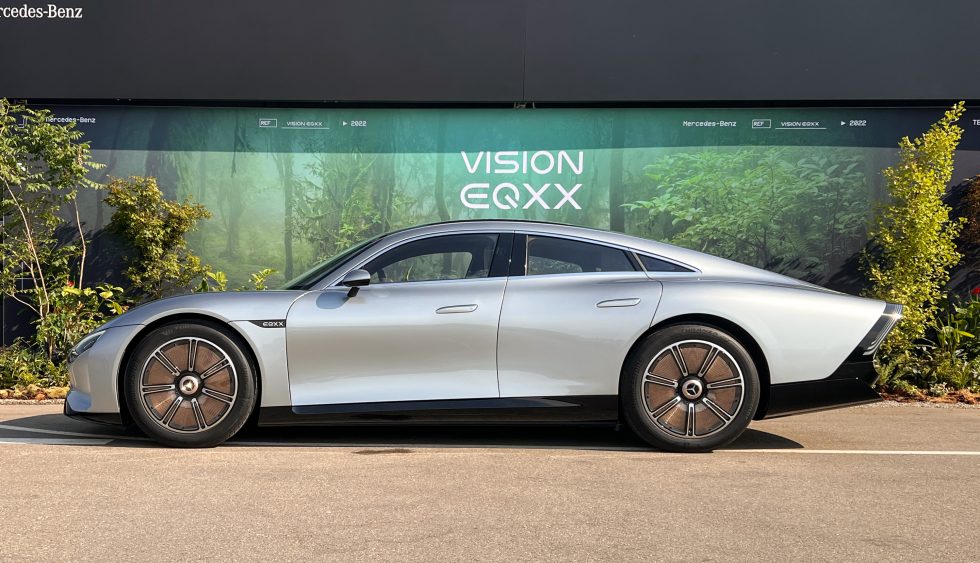
As you might guess from the way it looks, the Vision EQXX's shape is more than a little aero-optimized. About 62 percent of the work the motor has to do is fighting against air resistance, after all. It's a smaller car than it seems from the pictures—about a foot shorter than the production EQS at 195.9 inches long. And that includes the long overhanging nose and tail, so the Vision EQXX's wheelbase is actually compact car-short, at 110.2 inches (2,800 mm).
A narrow 73.6-inch (1,870-mm) width and low 53.1-inch (1,348-mm) roofline give the car a rather small frontal area—22.8 sq ft (2.12 m2)—and frontal area works with the drag coefficient, which in this case is just 0.17, which makes it one of the lowest-drag cars ever made.
From the nose to the C pillar it might remind you of the Porsche Taycan, a very slippery customer itself. The door handles retract flush to the doors, or at least they do up front; the rear doors don't open, one of the few tells that this really is a concept and not a production car.
The side view mirrors are of a size you might expect to find on a racing car rather than something wearing a license plate, but they work well enough. Which is good, because there's no rear window. Instead that space, and the roof too, is given over to a 300 w solar array that feeds into the car's 12 V battery which like the traction battery is also lithium ion. (Since the priceless one-off will never be left parked outside for very long, Mercedes didn’t bother adding the extra gubbins that would allow the panel to trickle-charge the traction battery.)
From the rear wheels back, it's like little else, other than perhaps the Lightyear Solo. When parked, the lower part of the tail retracts into the bodywork, extending out when the car's onboard brain decides its more efficient to do so.
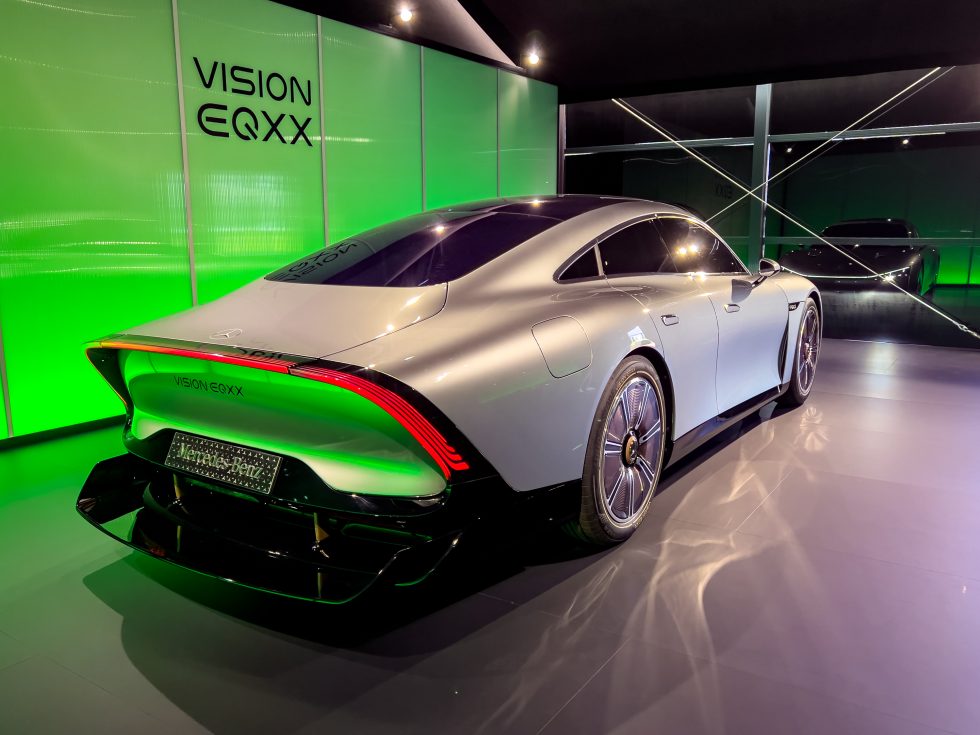
Rolling resistance is the next-most important factor in efficiency. The bespoke Bridgestone tires keep a tall and narrow profile at 185/60, but on 20-inch wheels. You can tell there's something clever going on with the tires just by how rounded the shoulders are, but a closer look reveals that even the text on the tires has been optimized not to stick out too much, lest it add more drag than necessary. And if the tires didn't give the game away, the disc-like wheels themselves provide the punchline.
Under the skin there's some more cleverness you can't see. The EQXX team tried out new topographical optimization techniques, applied after the normal finite element analysis that's used to predict how a part might react to heat or vibration. That explains the organic shape of the aluminum casting that forms part of the car's rear structure, which features load paths that no engineer would draw in CAD. But extensive simulation allowed the EQXX to go from blank sheet to that first drive to the south of France in less than two years.
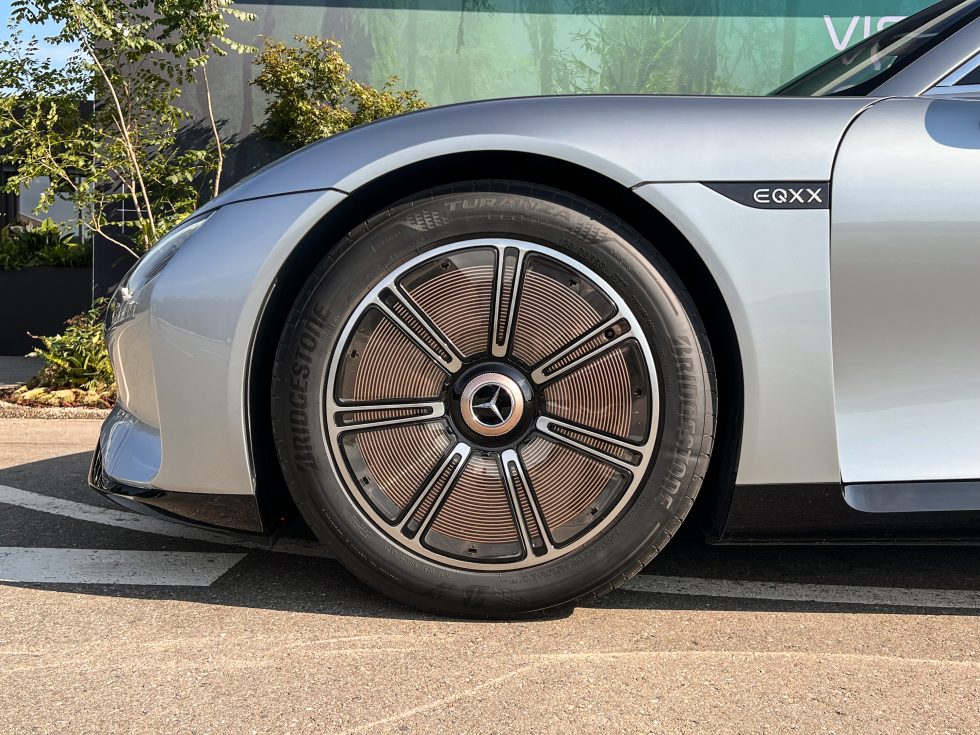
At the Vision EQXX's core is the lithium ion traction battery, protected in a carbon fiber shell made by the Mercedes-AMG Formula 1 team. Mercedes-AMG High Performance Powertrains, which builds the company's F1 powertrains, also supplied the power electronics, and collaborated on the car's software with Mercedes-Benz's North American research arm, although the car's single motor—which drives the rear wheels—was designed in Stuttgart.
Interestingly, the battery pack features no active cooling; instead it sits atop a big metal plate that provides structural protection but also acts as a heat sink. Ditching liquid cooling was a bold move, but that's what engineering projects like the Vision EQXX are for, and Mercedes' engineers told me that doing so not only saved a lot of weight but obviously also meant no need for a big radiator or the grille you'd want to feed it cold air. (There is a small grille behind an active shutter that opens when the climate control needs fresh air.)
As it needs to fit the EV's wheelbase, the battery pack is quite compact, and nothing is carried over from production electric Mercedes like the EQS. The cells are an R&D project, optimized for greater energy density, with more silicon in the anode than you'd find in the Mercedes-Benz EQS. It's rated at a useable 70.2 kWh, and operating at 920 V allows a lower overall current, which in turn allowed for thinner wiring, which saves even more weight. And yes, it even fast-charges, taking about 30 minutes to go from 10-80 percent.
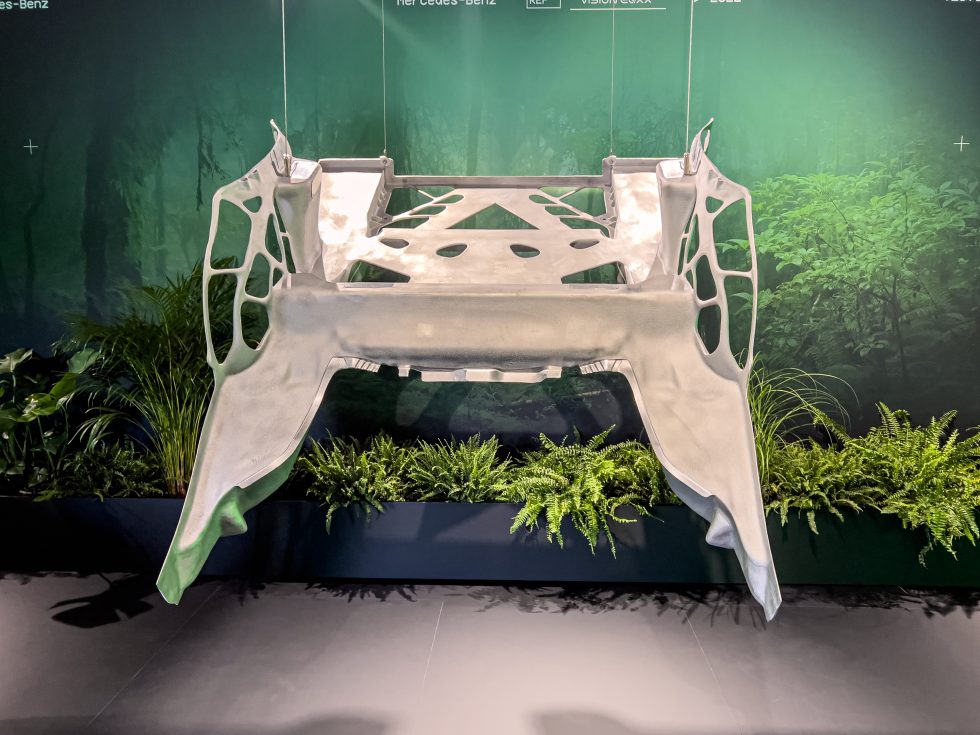
And despite its relatively compact size, it's not that light, with an unladen weight of 3,869 lbs (1,755 kg). But that does include an entirely functional interior with air conditioning and a heater and that big 8k screen. You can tell weight has been saved in the trim, but it's with an eye to saving weight on future products. The main giveaway that this is a working prototype and not a preproduction version of something in next year's showroom is the big red emergency stop button set into the roof, where you might expect to find the rear view mirror.
Plastic trim is latticed here and there, and instead of door handles there are fabric pulls, like a race car or stripped out Porsche. The cactus fiber fabric used to trim the seats and the plush bamboo rugs in the footwell sell the interior as a luxury car that deserves to wear the three-pointed star, but with an emphasis on recycled, sustainable, and cruelty free products instead of the wood and leather of the olden days.
Running an 8k screen all the time is a good way to waste energy, so this one uses local dimming and can even go into a Saab-like mode, where the whole thing goes black other than the critical information presented to the driver. That's represented as your speed in the center of a dark ball or dot.
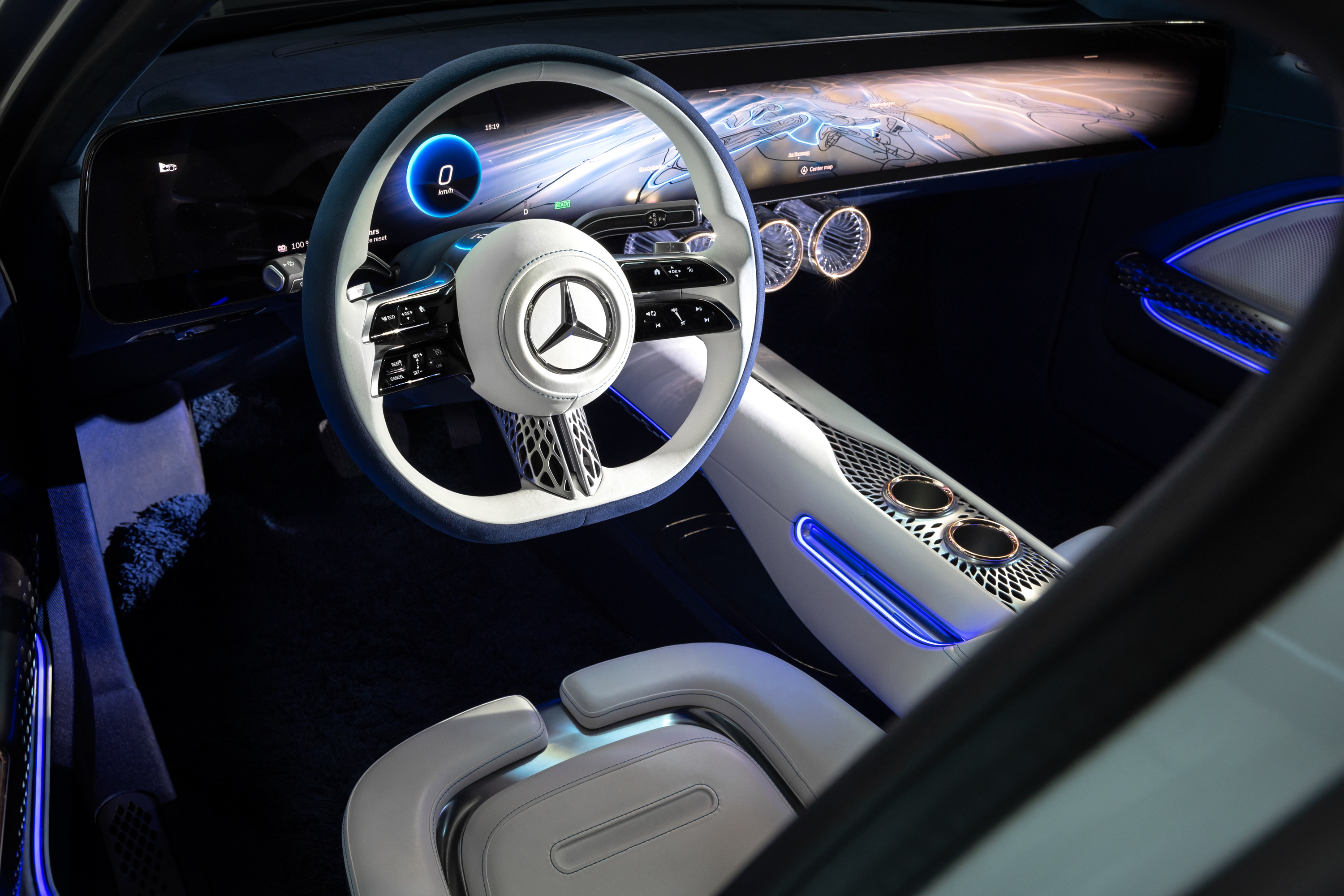 You might recognize the steering wheel from the EQS sedan. The 44-inch display is all-new, and is a single display, not multiple screens under glass.Mercedes-Benz
You might recognize the steering wheel from the EQS sedan. The 44-inch display is all-new, and is a single display, not multiple screens under glass.Mercedes-Benz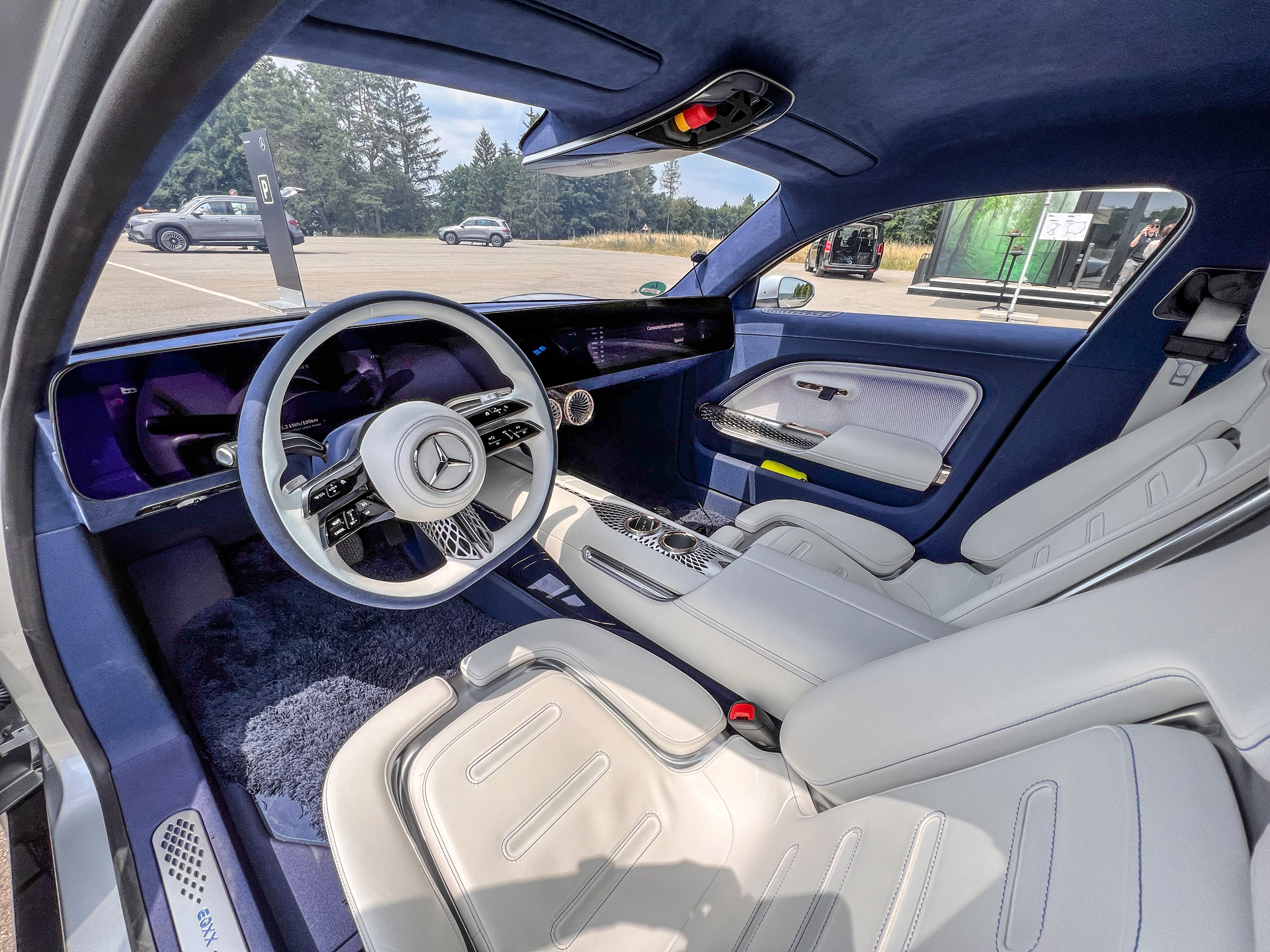 The big red emergency stop button on the roof is the main clue that you're in a prototype and not something production-ready.Jonathan Gitlin
The big red emergency stop button on the roof is the main clue that you're in a prototype and not something production-ready.Jonathan Gitlin Despite what you might think, the UI is actually not distracting for the driver—the animations are all for the benefit of the person in the right seat.Mercedes-Benz
Despite what you might think, the UI is actually not distracting for the driver—the animations are all for the benefit of the person in the right seat.Mercedes-Benz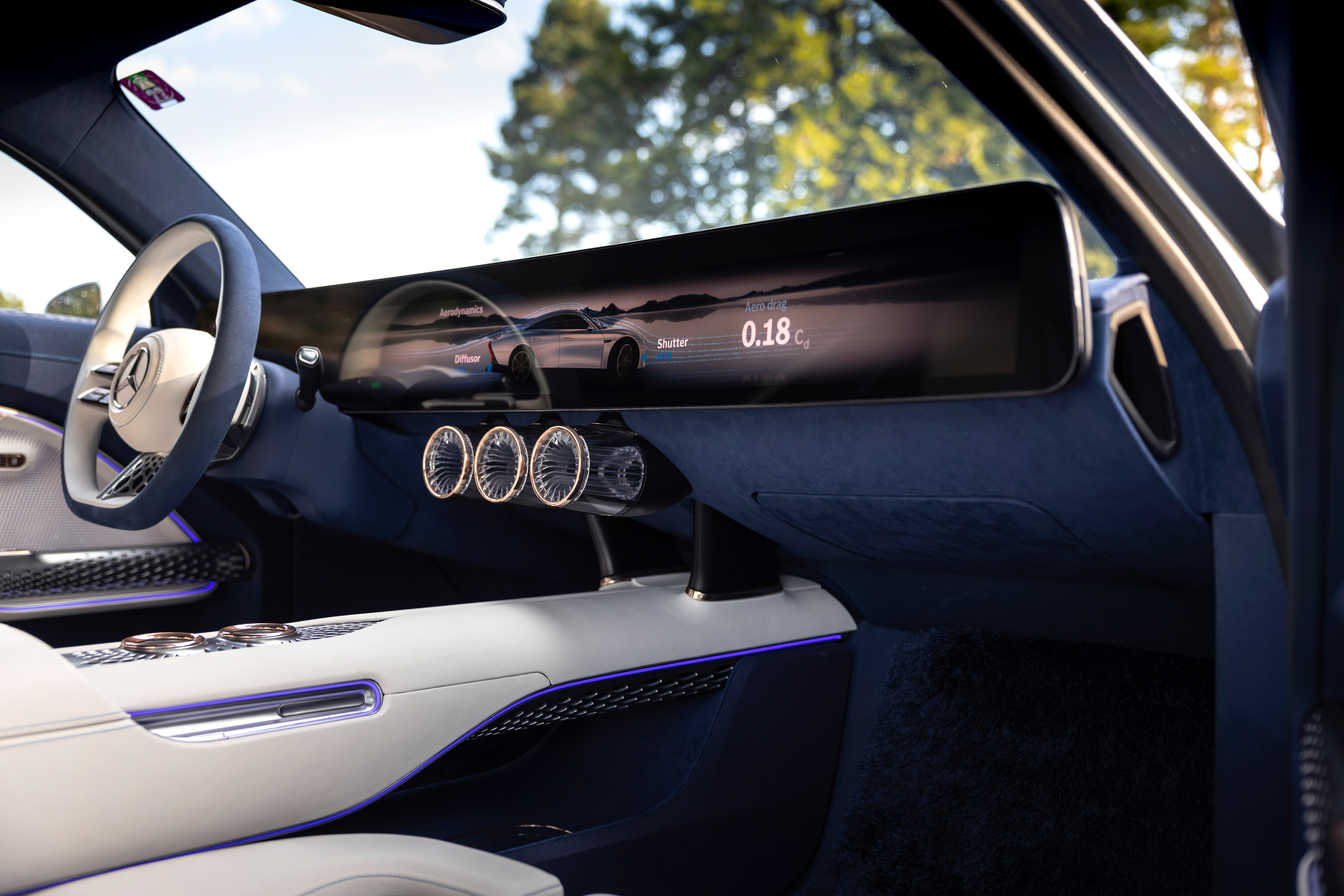 The Vision EQXX monitors its efficiency in real-time. You can see the drag coefficient is increased here because the active vent for the climate control is open.Mercedes-Benz
The Vision EQXX monitors its efficiency in real-time. You can see the drag coefficient is increased here because the active vent for the climate control is open.Mercedes-Benz
The Vision EQXX's onboard brain is constantly monitoring your efficiency, and relays that information to you as a nice calm blue glow around that dot. Accelerate too hard, or brake so much that you lose energy to friction, and it glows a nasty red. Everything is rendered in real-time in Unity, and there's also an onboard voice interface that's a further evolution of the one you'll find in the brand's MBUX infotainment system.
Before going for a drive in the Vision EQXX, Mercedes let us drive eMMA, the engineering mule that proved the hardware all worked together. eMMA started as an EQB crossover before losing its original powertrain so its drag coefficient was more like 0.28, and with a much bigger frontal area than the EQXX, obviously. And yet, over the 9.53-mile (15.34-km) test route at Mercedes' Immendingen it still achieved 5 miles/kWh (12.5 kWh/100 km).
Satisfied I wouldn't wreck the silver streamliner, it was time to drive it. Although the shape suggests a high top speed, the Vision EQXX is actually electronically limited to 87 mph (140 km/h). I only gave it full throttle once, at the urging of the Mercedes engineer in the passenger seat despite the fact it would affect my final efficiency figure, if only to see what would happen. And then only to 62 mph (100 km/h)—the test track constantly monitors the speed of every vehicle on its tarmac, and breaking the speed limit is not appreciated.
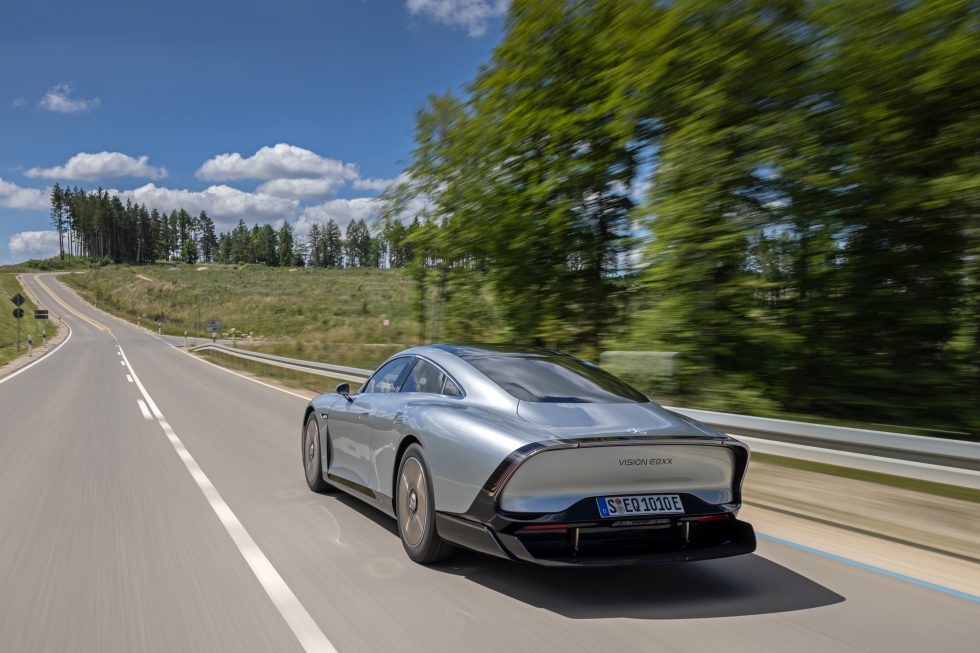
The 241-hp (180 kW) electric motor is plenty for a car of this size and shape, even on skinny, low-resistance tires. The motor's stator uses a copper winding technique borrowed from Mercedes' Formula E team, where powertrain efficiency is as important as it is here. The Vision EQXX gets close—overall it's at 95 percent efficiency, compared to 97 percent for the single-seat electric race cars.
Sitting so low, and with that view out over the curved wheel arches, called to mind the silver-painted sports prototypes that have carried Mercedes' badge on them at Le Mans, albeit at a quarter of the speed and none of the noise. The Vision EQXX handled well, at least as far as I was prepared to push it. But driving to conserve momentum has a charm all of its own.
Paddles behind the steering wheel spokes let you vary the amount of regenerative braking that happens when you lift your foot from the throttle pedal. The Vision EQXX also uses brake-by-wire so using the brake pedal would regeneratively brake, blending in the friction brakes as and when necessary.
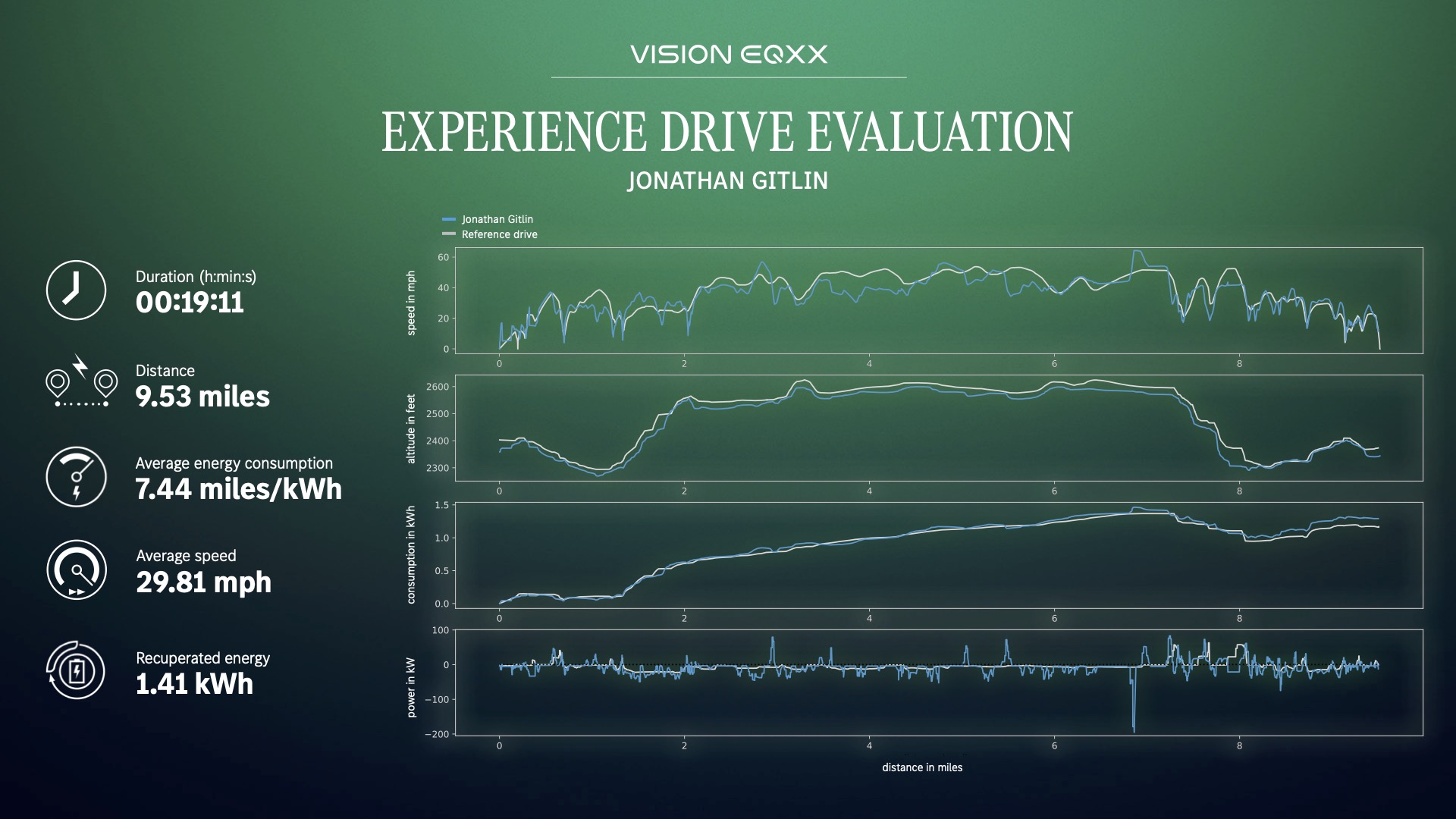 My data vs the reference drive.Mercedes-Benz
My data vs the reference drive.Mercedes-Benz Here's the same data but with metric units.Mercedes-Benz
Here's the same data but with metric units.Mercedes-Benz
Comparing my data to the reference trace, we can see that it would often have been more efficient to coast than one-pedal driving, even if I did regenerate 1.41 kWh compared to the 0.66 kWh regenerated by Mercedes' driver. On sections where eMMA would coast and lose a few mph, the Vision EQXX would instead pick up a little speed, and the car spent most of its time in no-regen mode during its two long demonstration drives earlier this year.
The glowing ball UI will be familiar if you've driven a Chevy Volt or Bolt, and is a great way to give a driver the feedback they need to drive efficiently. So while I wasn't quite as efficient as the reference drive, I achieved a respectable 7.44 miles/kWh (8.35 kWh/100 km), at an average speed of 29.81 mph (47.97 km/h). (Given a second chance I know that's beatable by coasting more and not accelerating hard that one time, but oh well.)
The Vision EQXX isn't destined for any kind of production, not even a limited run like Volkswagen's XL1 experiment. I see more demonstration drives in its future. I wasn't the only person to suggest a coast-to-coast US drive, or seeing how many laps of the Nürburgring Nordschleife it could do on a full charge—they'd be quite slow laps given that 87 mph top speed. But its real value is in the lessons Mercedes has learned, which it now has to apply to the cars it does want to sell.
"electric" - Google News
July 25, 2022 at 05:01AM
https://ift.tt/04lokO7
We test an electric Mercedes that can can go 747 miles on a single charge - Ars Technica
"electric" - Google News
https://ift.tt/rEMFjf0
https://ift.tt/Cd7H4xO
No comments:
Post a Comment